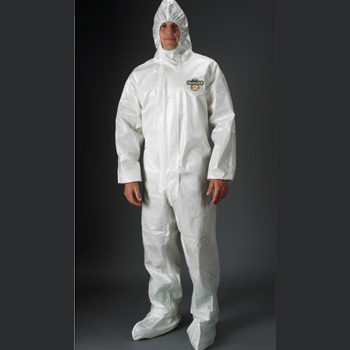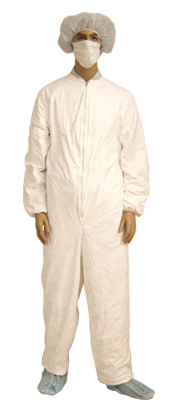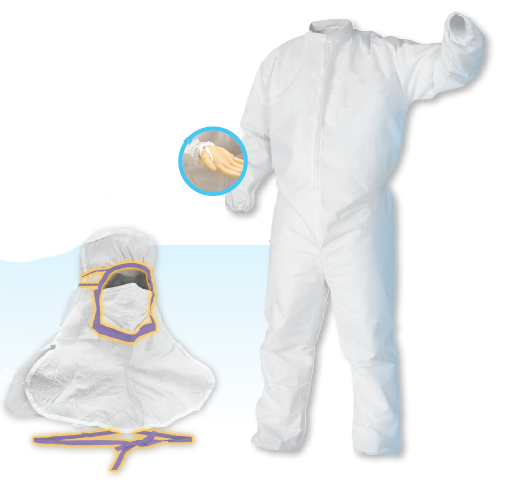
For this month we are going to focus on Cleanroom Apparel. To start I thought it would be best to define it, then we can go over where it is used, and finally point out some of the items that are trending this year. We would like to thank our partners at Dupont/Tyvek, Kimberly Clark, AlphaProTec and Lakeland Technologies for their help with this one!!
Cleanroom Apparel is apparel used in a cleanroom environment or an environment with a controlled level of contamination. There are separate pieces like bouffant caps, sleeve covers or all in one suits that cover all of you. There are also both re-useable and disposable garments, for this discussion we will only go over disposable pieces. Each environment has it’s own requirements for the apparel ranging from simple covers to airtight hazmat suits. I’ve learned it is very important to understand the environment and usage for the apparel before suggesting items. Due to recent events, many of us have become more familiar with a lot of this apparel that we refer to as PPE( personal protective equipment). Masks, face shields, gloves are all part of this category.
PPE manufacturers use different fabrics depending on the environment and the application they are being used, here are some of the fabrics we see:
SMS fabrics are a combination of spunbond and meltblown material layers that afford strength and abrasion properties along with being a protective barrier against light liquids, dust, dirt and grime.
Polypropylene fabrics are an economical solution designed for non-hazardous environments – and protection from dust, dirt and grime.
Proprietary fabrics that are specially designed by manufacturers to fit a specific need such as protection from hazardous and noxious particulates but still breathable to keep people cool and avoid heat stress. These specialty materials are used for mold remediation, manufacturing, handling hazardous chemicals, and other industrial applications. If working in a cleanroom environment, establish what level of cleanroom (or ISO Class if applicable) the work will be performed in as this will help with choosing the right level of personnel protection.
When choosing the correct PPE for your industrial, medical, lab, or cleanroom application, be sure to know your application well, be aware of hazardous chemicals, materials, or drug compounds being used in the application, and the level of protection required to safely protect workers in these environments.
Here are some words from Tim Nolan, a part of our sales team and someone that has experience with these products:
Earlier in my work life, I had been trained for work in the Hazmat Remediation Field. I was trained & certified to remove asbestos, lead, mold, and other dangerous materials. This work experience taught me a lot about being not only comfortable, but protected as well. What I didn’t like, were coveralls that felt like they were made out of thick paper that hardly seemed breathable. (they weren’t). Bad enough, I had to double don my coveralls, with gloves taped at the wrists, and the coverall also taped at the ankles. Add to this a hard hat, safety glasses and a ½ face respirator with a hood over all, and work being performed in a negative air environment.
Feeling uncomfortable yet?
Fortunately, there are alternative materials, like SMS, (Spunbond-Meltblown-Spunbond). I always opted for the SMS material when given the choice because it is more comfortable, and more importantly, breathable to the wearer.
SMS has many features like: light weight, high strength, more air permeability, hydrophilic properties, and excellent durability properties.
Todays’ spunbonds are now much more soft and comfortable than previous types in the past.
Please Note: PPE fabric choices may be dependent on the application being performed, so it is wise to make sure you have the correct material for the work being performed.
You will find cleanroom apparel in electronic part production, bio labs, pharmaceutical labs, and food manufacturing. There are guidelines for each industry, each application that will tell you which pieces of apparel are necessary. You can look OSHA (Occupational Safety and Health Administration) for many of these guidelines. Now that we have an idea of what we need, or would need based on guidelines, lets look at some of our top picks!!
Tyvek is a big seller when it comes to apparel, the name is almost synonymous with critical environments. This is the brand that is used most often and we are excited to offer it. Check out an example of their coveralls, always a top seller.
Kimberly Clark is very popular among our customers. The most popular items we have are A5 and A8 clean room apparel. The A5 is deigned to prevent people from contaminating the work space. It is great for mixing, filling, and cleaning. The A8 is geared toward the bioburden control areas. It is used in ISO class-8 areas.

Lakeland Industries current top seller is their cleanmax apparel. Known for high quality construction and attention to detail, these pieces are perfect for clean room settings. Available in both sterile and non-sterile as well!
AlphaProtec was kind enough to share some top sellers. Since the start of the pandemic masks and face shields have been very popular, be sure to check the links to see some great examples. Some of the other top sellers are shoe covers and coveralls.

We invite you to check out these products and more at CT Cleanroom and email [email protected] with any questions or quote requests!


